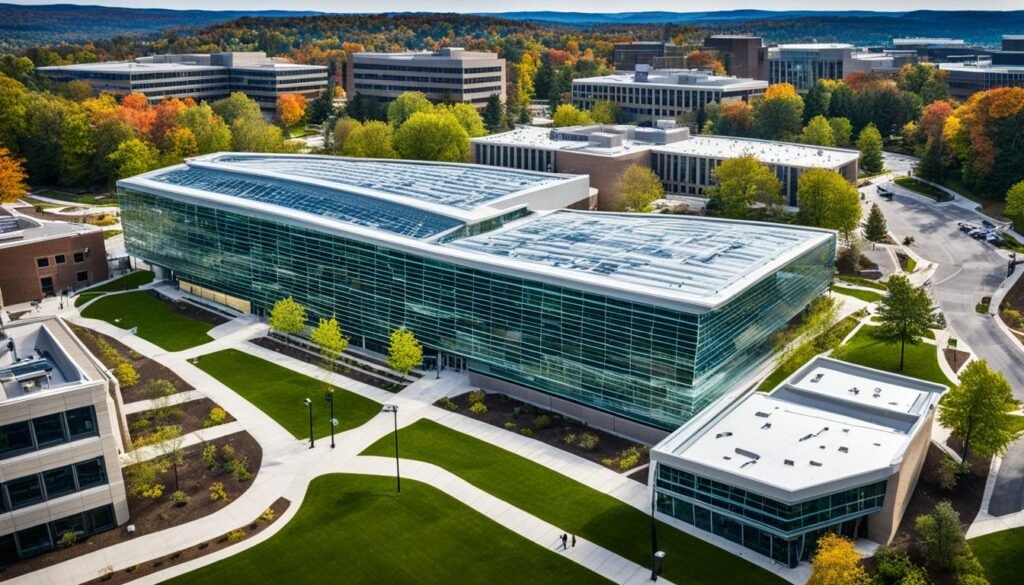Welcome to the fascinating world of architectural engineering! From designing structurally sound buildings to overseeing their construction, architectural engineers play a crucial role in shaping our built environment. If you have a passion for combining engineering design and construction principles with innovative architectural concepts, then a graduate program in architectural engineering may be the perfect fit for you.
At the College of Engineering, we offer a comprehensive architectural engineering program that prepares students for a career at the intersection of engineering and architecture. Our program focuses on equipping graduates with the skills and knowledge necessary to design functional, sustainable, and aesthetically pleasing structures.
Key Takeaways:
- Architectural engineering is a multidisciplinary field that combines engineering principles with architectural design and construction.
- The graduate program in architectural engineering at the College of Engineering emphasizes structural engineering, engineering design, and construction in the built environment.
- Architectural engineers play a crucial role in designing and constructing sustainable and aesthetically pleasing buildings.
- The program prepares students for a career at the intersection of engineering and architecture.
- By pursuing a graduate program in architectural engineering, you can develop the skills needed to create innovative and functional structures.
Exploring Architectural Engineering: A Multifaceted Field
Architectural engineering is a multifaceted field that encompasses various disciplines such as design, construction, and structural systems. Aspiring architectural engineers undertake a bachelor’s degree program in architectural engineering, where they gain a comprehensive understanding of the principles and practices involved in building design and construction.
One of the key aspects of architectural engineering is the execution of design projects. Architectural engineers collaborate closely with architects to transform creative visions into functional and structurally sound buildings. These projects require a deep understanding of architectural aesthetics and the ability to incorporate engineering principles into the design.
Structural systems form the backbone of any building, and architectural engineers play a vital role in designing and analyzing these systems to ensure their strength and stability. Through advanced simulation techniques, such as computer-aided structural analysis, architectural engineers can accurately model and predict the behavior of structural elements, enabling them to optimize designs for efficiency and safety.
At the heart of architectural engineering lies a commitment to sustainability. Architects, in collaboration with architectural engineers, strive to create eco-friendly buildings that minimize their environmental impact. From energy-efficient building systems to sustainable materials and technologies, sustainability is a driving force in architectural engineering.
“Architectural engineering combines creativity, technical proficiency, and sustainable practices to shape the built environment.”
Accreditation plays a crucial role in ensuring the quality and standardization of architectural engineering programs. Accredited programs have undergone rigorous evaluation and meet the educational standards set by accrediting bodies, such as the Accreditation Board for Engineering and Technology (ABET). Graduating from an accredited program provides students with recognition and assurance of their educational qualifications, enhancing their career prospects in architectural engineering.
In summary, architectural engineering is a multidisciplinary field that encompasses design projects, structural systems, and sustainability. Architectural engineers collaborate closely with architects to bring creative visions to life while ensuring the structural integrity and sustainability of buildings. By pursuing a bachelor’s degree in architectural engineering and gaining accreditation, aspiring architectural engineers can embark on a fulfilling career in shaping the future of the built environment.
| Aspects of Architectural Engineering | Keywords |
|---|---|
| Design Projects | design project |
| Structural Systems | structural systems |
| Bachelor’s Degree Program | bachelor |
| Sustainability | sustainability |
| Accreditation | accredit |
The Department of Architectural Engineering at Penn State
Penn State’s Department of Architectural Engineering (AE) is renowned for its state-of-the-art facilities and commitment to excellence in civil engineering education. As a part of the esteemed Penn State Engineering program, AE offers a comprehensive architectural engineering degree that equips students with the skills and knowledge necessary to thrive in the field.
One of the department’s key strengths lies in its integration with civil engineering, allowing students to develop a deep understanding of both disciplines. This unique collaboration creates opportunities for an interdisciplinary approach to architectural engineering, where students gain expertise in structural design, construction methods, and sustainable building practices.
AE at Penn State is closely affiliated with the Architectural Engineering Institute (AEI), a professional organization that promotes excellence in architectural engineering education and practice. This affiliation provides students with access to the latest industry insights, networking opportunities, and research collaborations.
Students enrolled in the architectural engineering program at Penn State benefit from a curriculum that balances theoretical knowledge with hands-on experience. Through internships, co-op programs, and industry partnerships, students have the chance to apply their skills in real-world scenarios and build a strong foundation for their future careers.
As an AE major at Penn State, students can choose from various areas of specialization, such as lighting design, HVAC systems, and building energy efficiency. This flexibility allows students to tailor their degree to their specific interests and career goals.
With a focus on fostering technical expertise, critical thinking skills, and creativity, the Department of Architectural Engineering at Penn State is committed to producing world-class architectural engineers who contribute to the advancement of the built environment.
Facilities and Research Opportunities
The AE department boasts state-of-the-art laboratories and research facilities that provide students with valuable hands-on experience and opportunities for innovation. These facilities include dedicated spaces for structural testing, environmental control, lighting design, and much more.
Research opportunities are plentiful, with faculty members actively engaged in cutting-edge research projects focused on sustainable building design, energy efficiency, and construction materials. Students have the opportunity to collaborate with faculty on research projects, enhancing their understanding of complex engineering problems and contributing to the development of innovative solutions.
Architectural Engineering Degree Program
The architectural engineering degree program at Penn State offers a comprehensive curriculum that combines foundational engineering courses with specialized coursework in areas such as structural systems, building envelope design, and construction management.
Throughout their studies, students gain a solid understanding of building systems, including structural, electrical, mechanical, and environmental systems. They also learn to apply engineering principles to architectural design and develop skills in computer-aided design (CAD), simulation, and analysis software.
Table:
| Program | Duration | Accreditation |
|---|---|---|
| Bachelor of Architectural Engineering | 4 years | ABET |
| Master of Architectural Engineering | 2 years | ABET |
| Ph.D. in Architectural Engineering | Varies | ABET |
Upon completion of the program, graduates are well-equipped to pursue a variety of career paths in architectural engineering, consulting firms, construction companies, and government agencies, among others.

Building Systems: Integrating Engineering Principles
In architectural engineering at Penn State, building systems play a crucial role in the design and construction process. These systems, which integrate engineering principles, are essential for creating functional and sustainable buildings. By incorporating various components such as structural, electrical, HVAC, and lighting systems, architectural engineers ensure the efficient operation and comfort of the built environment.
Student participation in design competitions is an integral part of the architectural engineering program at Penn State. These competitions provide students with real-world experience and the opportunity to apply their knowledge of architectural design and engineering aspects. Through these competitions, students have the chance to showcase their creativity and problem-solving skills, gaining recognition and opening doors to future career opportunities.

Student Design Competitions: Fostering Innovation
“Student design competitions offer architectural engineering students a platform to explore innovative approaches to architectural design and engineering integration. These competitions drive students to think outside the box, pushing the boundaries of what is possible in building design and construction. It’s a chance for students to apply theoretical knowledge in a practical context and gain valuable hands-on experience.”
The interdisciplinary nature of architectural engineering allows students to develop a holistic understanding of the built environment. Through coursework and collaborative projects, students learn how to optimize building systems for energy efficiency, sustainability, and occupant comfort. By combining architectural design and engineering expertise, architectural engineers play a vital role in shaping the future of the built environment.
Benefits of Student Design Competitions
| Benefits | Description |
|---|---|
| Practical Experience | Students can apply their knowledge to real-world design challenges, gaining hands-on experience. |
| Networking Opportunities | Competitions provide a platform to connect with industry professionals and potential employers. |
| Creative Problem-Solving | Students develop critical thinking and problem-solving skills through innovative design solutions. |
| Recognition | Participation in competitions can enhance students’ portfolios and increase their visibility in the industry. |
By integrating engineering principles into architectural design, architectural engineering at Penn State prepares students to excel in the multifaceted field of building systems. Through participation in student design competitions, students have the opportunity to apply their knowledge, foster innovation, and shape the future of architectural design and construction.
Sustainable Architecture: Designing for the Future
In the field of architectural engineering, sustainability is a crucial aspect of design and construction. As the world continues to prioritize environmentally friendly practices, architectural engineers play a key role in creating sustainable buildings that minimize their impact on the environment.
For individuals interested in pursuing a career in architectural engineering, there are bachelor’s and master’s degree programs available that focus on sustainable architecture. These programs provide students with the necessary knowledge and skills to design and construct buildings that are energy-efficient and environmentally responsible.
By obtaining a bachelor of architectural engineering or a master of architectural engineering degree, students can develop the expertise needed to become world-class architectural engineers. These programs emphasize the importance of sustainable design principles and provide students with the tools to incorporate them into their projects.
In addition to the academic coursework, these degree programs also offer opportunities for research and exploration. Students can engage in research projects that focus on sustainable architectural practices, allowing them to contribute to the development of innovative solutions for the future.

“Sustainable architecture is not only about being environmentally friendly, but it also considers social and economic aspects. Architects and engineers must work together to create buildings that are energy-efficient, functional, and aesthetically pleasing.”
By encouraging the development of world-class architectural engineers and promoting research in sustainable architectural practices, the field of architectural engineering can make a significant impact on the future of the built environment. These graduates will be equipped to design and construct buildings that prioritize energy efficiency, minimize waste, and enhance the overall quality of life for occupants.
Key Takeaways:
- Sustainable architecture is a critical focus in architectural engineering.
- Bachelor’s and master’s degree programs in architectural engineering provide the necessary knowledge and skills for sustainable design.
- These programs contribute to the development of world-class architectural engineers.
- Research opportunities allow students to explore innovative sustainable architectural practices.
It is clear that sustainable architecture is not just a trend, but a crucial element in the future of architectural engineering. By integrating sustainability principles into the design and construction process, architectural engineers can contribute to creating a greener and more sustainable built environment.
Advancing the Built Environment: Innovations and Best Practices
In the field of architectural engineering, advancements and best practices are crucial for pushing the boundaries of the built environment. Through innovative approaches and continuous research, professionals in this field strive to enhance the design and functionality of buildings. Let’s explore some key areas of focus that contribute to these advancements.
HVAC Systems: Embracing Efficiency and Comfort
Efficient HVAC (Heating, Ventilation, and Air Conditioning) systems play a vital role in creating comfortable and sustainable indoor environments. Architectural engineers are at the forefront of developing innovative HVAC solutions that balance energy efficiency, occupant comfort, and environmental impact. From designing intelligent control systems to implementing renewable energy sources, the focus is on creating optimal environments that promote well-being.
Lighting Design: Illuminating Spaces with Precision
Lighting design is an essential aspect of architectural engineering, influencing the ambiance and functionality of indoor and outdoor spaces. With advancements in LED technology and automation, architectural engineers strive to create lighting schemes that are energy-efficient, aesthetically pleasing, and tailored to specific needs. By incorporating natural lighting, optimizing placement, and implementing smart control systems, architectural engineers can enhance visual comfort and reduce energy consumption.
Internships: Bridging Theory and Practice
Internship opportunities provide aspiring architectural engineers with valuable hands-on experience in the industry. These internships offer students the chance to apply their theoretical knowledge to real-world projects, under the guidance of experienced professionals. Through internships, students gain practical insights into engineering design processes, construction techniques, and industry standards. It also provides them with a network of contacts and the opportunity to showcase their skills to potential future employers.
Innovative Building Materials: Paving the Way for Sustainable Construction
The integration of sustainable building materials is a key aspect of architectural engineering practices. From advanced insulation materials to renewable energy technologies, experts in the field explore and adopt materials that minimize environmental impact while maintaining structural integrity. By utilizing recycled materials, embracing renewable resources, and implementing green building practices, architectural engineers contribute to the creation of environmentally responsible buildings.
Research Opportunities: Advancing the Knowledge Base
Education and research go hand in hand in the field of architectural engineering. Through research opportunities, students and professionals have the chance to delve deeper into complex design challenges, explore emerging technologies, and develop innovative solutions. By actively engaging in research projects, architectural engineers contribute to the continuous improvement of the discipline and advance the knowledge base of the entire industry.
Engineering Design of Buildings: Integrating Multiple Disciplines
Architectural engineering involves the integration and coordination of multiple engineering disciplines. From structural engineering to mechanical and electrical systems, architectural engineers ensure that all components of a building work together seamlessly. By collaborating with architects, construction teams, and other specialists, they ensure the successful realization of design concepts while meeting safety, efficiency, and sustainability requirements.

By embracing these advancements and implementing best practices, architectural engineers play a crucial role in shaping the future of the built environment. Through their expertise in HVAC systems, lighting design, innovative building materials, internships, research opportunities, and the engineering design of buildings, they contribute to the creation of sustainable, functional, and aesthetically pleasing structures.
The next section will explore how architectural engineering enhances indoor environments for maximum comfort and efficiency.
Enhancing Indoor Environments: Comfort and Efficiency
Architectural engineering plays a pivotal role in enhancing indoor environments for optimal occupant comfort and energy efficiency. It is a career field that offers exciting opportunities for those passionate about creating sustainable and functional spaces. The undergraduate architectural engineering program at the Department of Civil is designed to equip students with the necessary skills and knowledge to excel in this field.
The AE program combines the principles of architecture and engineering, integrating math and science with design concepts. Students gain a comprehensive understanding of building systems, including lighting systems, which are crucial for creating comfortable and well-lit indoor spaces. Through practical coursework and hands-on projects, students develop expertise in designing lighting systems that maximize energy efficiency while ensuring occupant well-being.
Graduates of the undergraduate architectural engineering program are well-prepared to pursue a successful architectural engineering career. The program equips students with a solid foundation in engineering principles and design concepts, enabling them to contribute to the development of sustainable and innovative buildings. As the demand for energy-efficient and environmentally conscious solutions continues to grow, architectural engineers are increasingly sought after in the building industry.
As we look ahead to 2022 and beyond, the field of architectural engineering presents exciting opportunities for aspiring professionals. With advancements in technology and a growing emphasis on sustainable design practices, architectural engineers have the chance to make significant contributions to the built environment. By integrating their expertise with other disciplines such as civil engineering and lighting systems, architectural engineers can create indoor environments that prioritize occupant comfort, energy efficiency, and overall well-being.

The table below provides an overview of the undergraduate architectural engineering program:
| Program Details | Department of Civil |
|---|---|
| Program Name | Bachelor of Architectural Engineering |
| Duration | 4 years |
| Coursework | – Math and Science Foundations – Architectural Engineering Core Courses – Lighting Systems – Building Energy Analysis – Structural Systems – Design Projects |
| Career Opportunities | – Architectural Engineer – Lighting Designer – Energy Analyst – Sustainability Consultant |
| Accreditation | ABET (Accreditation Board for Engineering and Technology) |
In conclusion, the field of architectural engineering offers a prosperous career path for those interested in creating comfortable and efficient indoor environments. The undergraduate architectural engineering program at the Department of Civil provides students with the necessary knowledge and skills to excel in this dynamic industry. By integrating math and science with architectural design principles, students can contribute to the development of sustainable and innovative buildings, ensuring a better future for all.
Constructing Sustainable Buildings: An Integrated Approach
When it comes to constructing sustainable buildings, an integrated approach is essential. Architects and architectural engineers collaborate closely to ensure that the design and construction of buildings are structurally sound and environmentally friendly. This multidisciplinary collaboration between the architect and the architectural engineer leads to the creation of sustainable structures that meet the needs of both the occupants and the environment.
Architectural engineering majors play a crucial role in the design and construction process. As students majoring in architectural engineering, they gain a deep understanding of building design and construction, equipping them with the knowledge and skills to contribute to the development of sustainable buildings. With a focus on electrical systems, architectural engineering students learn how to incorporate energy-efficient technologies into building designs, contributing to the overall sustainability of the project.
“An integrated approach to constructing sustainable buildings is about harnessing the expertise of both architects and architectural engineers. This collaboration allows us to create structures that are not only aesthetically pleasing but also environmentally responsible.”
– John Adams, Architectural Engineer
The multidisciplinary nature of architectural engineering extends beyond collaboration with architects. It involves working with professionals from various fields, such as civil engineering, construction management, and environmental science, to ensure that every aspect of the building design and construction process aligns with sustainable principles. This holistic approach ensures that all elements, including structural integrity, energy efficiency, and environmental impact, are taken into consideration.
Benefits of an Integrated Approach
- Enhanced sustainability: By incorporating sustainable design principles from the early stages of building design, an integrated approach helps minimize the ecological footprint of buildings.
- Optimized building performance: Integrating architectural design with engineering expertise improves a building’s structural integrity, energy efficiency, and overall performance.
- Creative problem-solving: Collaborative efforts allow for innovative solutions to complex design and construction challenges, resulting in unique and sustainable buildings.
- Cost-effective solutions: By considering different factors simultaneously, an integrated approach can lead to cost savings over the building’s lifecycle.
With an integrated approach, the field of architectural engineering continues to drive the construction industry towards a sustainable future. By combining the knowledge and skills of architects and architectural engineers, we can create buildings that not only meet the needs of the present but also contribute to a better tomorrow.
Embracing Innovation: The Future of Architectural Engineering
In the ever-evolving field of architectural engineering, embracing innovation is key to shaping the future. Let’s explore some of the innovative aspects that drive this dynamic discipline forward.
Senior Design Projects: Fostering Creativity and Design
Senior design projects play a crucial role in the development of architectural engineering students. These projects provide an opportunity for students to apply their knowledge and skills to real-world challenges, fostering creativity and design thinking. By tackling complex problems, students gain valuable experience and prepare themselves for the interdisciplinary nature of the industry.
Engineering Areas of Focus: Enhancing Indoor Air Quality
Architectural engineering encompasses various engineering areas of focus, each contributing to the overall design and functionality of buildings. One critical area of focus is indoor air quality, as occupant health and comfort are paramount. Architectural engineers utilize innovative ventilation and air conditioning systems to ensure optimal indoor air quality, providing a conducive environment for building occupants.
The Interdisciplinary Nature of Architectural Engineering
Architectural engineering is an interdisciplinary field that brings together various disciplines such as architecture, civil engineering, electrical engineering, and mechanical engineering. This collaboration allows professionals to approach projects from different perspectives, fostering innovation and pushing the boundaries of traditional design and construction practices.
Ensuring Occupant Comfort: A Priority for Architectural Engineers
In the pursuit of innovative architectural design, occupant comfort remains a top priority. Architectural engineers design spaces that prioritize functionality, efficiency, and user experience. By integrating engineering principles with architectural aesthetics, they create environments that not only inspire but also provide optimal comfort for the occupants.
The future of architectural engineering lies in the hands of students who complete their studies with a deep appreciation for creativity and design. By embracing innovation, these future professionals will continue to push the boundaries of what is possible in the built environment.
Also Read:- Unlocking The Value: Understanding Lump Sum Life Insurance Cash Value
Building a Sustainable Future: Architectural Engineering and the Building Industry
In the ever-evolving world of architectural engineering, the impact on the building industry is profound. Through innovative thesis design projects and adherence to ABET accreditation standards, architectural engineers advance the built environment by pioneering sustainable practices and leveraging the interdisciplinary nature of the field.
Advancing Through Multi-disciplinary Collaboration
Architectural engineering encompasses the construction and operation of buildings, making it a vital discipline in the building industry. By collaborating with design firms, architectural engineers bring their expertise to the table, ensuring that building envelopes, mechanical systems, and sensor technology prioritize sustainability and efficiency.
With their unique skill set, architectural engineers become licensed professional engineers, at the forefront of designing sustainable buildings. Their contributions not only shape the physical landscape but also impact the social and economic aspects of our built environment.
The Power of Thesis Design Projects
Thesis design projects form a cornerstone of architectural engineering education, enabling students to delve deeply into real-world challenges and propose innovative solutions that advance the built environment. These projects push the boundaries of design, incorporating cutting-edge technologies and sustainable practices.
“Through thesis design projects, architectural engineering students develop a profound understanding of the multi-disciplinary aspects of the field and showcase their ability to tackle complex challenges head-on, paving the way for a sustainable future.”
ABET Accreditation: Ensuring Excellence
Architectural engineering programs accredited by ABET provide a solid foundation for students to become leaders in the building industry. ABET accreditation validates the quality of education and ensures that architectural engineers are equipped with the necessary knowledge and skills to create sustainable and efficient spaces.
By adhering to ABET standards, architectural engineering programs maintain a high level of educational excellence. Graduates from these programs are well-prepared to face the demands of a constantly evolving industry and make significant contributions to the built environment.
The Path to a Sustainable Future
Architectural engineering plays a crucial role in advancing the built environment, promoting sustainable practices, and driving innovation. Through the development and operation of buildings, architectural engineers create spaces that optimize energy usage, enhance occupant comfort, and minimize environmental impact.
With a focus on building envelopes, mechanical systems, and sensor technology, architectural engineers utilize their technical expertise and creativity to design and construct buildings that are energy-efficient, sustainable, and adaptable to changing needs. By embracing the principles of sustainability and leveraging advancements in technology, architectural engineering ensures a sustainable future for generations to come.
Conclusion
Throughout this article, we have explored the multifaceted field of architectural engineering and its role in shaping the future of the built environment. We have highlighted the importance of the architectural engineering program offered by the College of Engineering at Penn State, with its focus on structural engineering, design, and construction.
Architectural engineering is a multidisciplinary field that integrates various engineering principles, from structural systems to HVAC and lighting design. Sustainability is a key aspect of architectural engineering, with a focus on creating energy-efficient and environmentally-friendly buildings.
As we look to the future, the role of architectural engineers becomes even more vital. Their expertise in enhancing indoor environments, embracing innovation, and constructing sustainable buildings will contribute to a more sustainable and functional built environment.
FAQs
What is architectural engineering?
Architectural engineering is a multidisciplinary field that combines principles of architecture and engineering to design and construct buildings. It focuses on the integration of structural, mechanical, electrical, and plumbing systems, as well as energy efficiency and sustainability in building design and construction.
What can I do with a graduate degree in architectural engineering?
With a graduate degree in architectural engineering, you can pursue advanced research opportunities, specialize in specific topics such as structural systems or building energy modeling, and enhance your career prospects in the field of architectural engineering. It can also provide you with a competitive edge in the job market.
Which college offers an architectural engineering program?
The College of Engineering at Penn State offers an architectural engineering program. The program focuses on the design and construction of the built environment, with an emphasis on structural engineering and sustainability.
How long does it take to complete a bachelor’s degree in architectural engineering?
A bachelor’s degree in architectural engineering typically takes four years to complete, although some programs may offer an accelerated track or additional coursework options that can extend the program duration.
Is the architectural engineering program accredited?
Yes, the architectural engineering program at Penn State is accredited by the Accreditation Board for Engineering and Technology (ABET). This accreditation ensures that the program meets the highest standards of education and prepares students to become licensed professional engineers.
What research opportunities are available in architectural engineering?
The Department of Architectural Engineering at Penn State offers research opportunities in various areas such as sustainable architecture, building materials, energy efficiency, and indoor air quality. These research opportunities allow students to gain hands-on experience and contribute to the advancement of the field.
What are the career prospects for architectural engineering graduates?
Architectural engineering graduates have excellent career prospects in the building industry. They can work in architectural design firms, construction companies, consulting firms, government agencies, or pursue further education and research in the field. Architectural engineering graduates are in high demand due to their multidisciplinary skill set and expertise in designing sustainable and efficient buildings.
What are the specific areas of focus in the architectural engineering program?
The architectural engineering program at Penn State focuses on various areas including structural systems, HVAC systems, lighting design, construction technology, and building envelopes. These specific areas of focus prepare students to design and construct buildings that are structurally sound, energy-efficient, and environmentally sustainable.
Can I become a licensed professional engineer with a degree in architectural engineering?
Yes, with a degree in architectural engineering and by meeting the licensure requirements, you can become a licensed professional engineer. Licensure requirements typically include completing a bachelor’s degree in engineering, passing the Fundamentals of Engineering (FE) exam, gaining relevant work experience, and passing the Professional Engineering (PE) exam.
What is the role of architectural engineers in sustainable architecture?
Architectural engineers play a crucial role in designing sustainable buildings. They integrate energy-efficient systems, employ sustainable materials, and utilize advanced technologies to reduce energy consumption, promote indoor air quality, and enhance occupant comfort. Their expertise ensures that buildings are environmentally friendly and economically viable.

